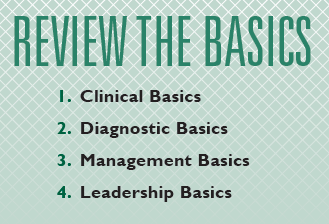
Optimizing Basic Skills for Advanced Results.
For the past several years, I’ve taught seminars with the Dr. Dick Barnes Group (DDBG). The overall goal for this group is to help dentists become better and more productive. I keep that philosophy in mind with every course that I teach—whether it’s a Full Arch Reconstruction course, a Hands-On Clinical course, or a Know Your Numbers course.
As an educator, I’ve been welcomed into dental practices across the country. I’ve seen and heard a lot of different things. Some doctors are tearing it up—opening multiple practices and seeing plenty of patients. Other doctors, though, are struggling—and despite working hard and exhausting themselves, they aren’t seeing very many patients in a day.
For dentists who are frustrated, and whose financial revenues aren’t where they need to be, it might be time to go back to the basics. “But wait,” the dentist always says. “I’ve been practicing for ten/twenty/thirty years! I’m way beyond the basics!”
However long you’ve been practicing, it’s beneficial to review the basics in order to analyze whether there is room for improvement. Maybe advancements in technology could help the practice. Maybe you could learn how to prep faster and more efficiently. What if you could discover one small adjustment to the way you hold your handpiece that would alleviate tension and allow you to take fewer breaks in a day? Wouldn’t you want to learn a tip that would allow you to be able to perform more procedures in a day?
Going back to the basics is a simple but powerful idea. And it’s one that helps all dentists—not just the newbies—become better and more productive. Dentists should always be looking at ways to improve their practices, and sometimes reviewing the basics is all that it takes to achieve extraordinary results.

Clinical Basics
Last September, I taught a private training course for a group of dentists and their dental teams. This dental group was made up of about 10 dental practices, with some dentists who were just out of dental school, and others with 30 years of experience or more. This particular dental group opted to fly me in to train their group, rather than fly their group to Utah for training. During the course, I was with Chelsea Brock, a sales representative from Arrowhead Dental Laboratory, who helped organize the logistics of the trip.
We were expecting to do a full arch reconstruction course and possibly teach parts of the occlusion course. However, it’s impossible to jump into a full mouth or full arch reconstruction case unless dentists are comfortable with all the steps leading up to it. Over the weekend, we discovered that the most beneficial thing for those doctors to learn was not how to segment a full arch, but simply how to prep a single tooth.
Although the doctors all knew how to prep a single tooth, they didn’t necessarily know the optimal way to do it. The course started from there, and it was like a series of light bulbs going off for many of the doctors. We brought several models for them to practice prepping on, and after two or three tries with the new techniques, they really started to catch on.
Learning the optimal technique helped increase their efficiency and accuracy—not only for the structure of the tooth they were working on, but also with regard to the impressions and how they should send them to labs so they could fabricate great restorations and have truly predictable results. The doctors learned optimal techniques that were efficient and precise.

During the course, I showed the doctors how to prep a tooth (both posterior and anterior) in a way that was conservative, and that saved a lot of tooth structure, with clear, defined margins. I also showed them how to fill a cavity. And I showed them how to drill, which was helpful even for dentists who had been in practice many years. My objective was to help dentists see their world differently—for the better.
While drilling, it’s tempting to stop and lift up your hand for 10 seconds or so when you’re prepping a tooth. But it’s much more efficient to keep drilling and not stop. Sometimes not lifting a hand for a full 10 seconds is an achievement! I literally held my hand over some of the dentists’ hands while they were drilling because it’s so hard to change old habits, and they needed to feel how to do it properly.
I had my hand on theirs and said, “Don’t peck, but look at the drill bit and where you are focusing it.” Then I would ask, “Are you going to push the side in or the tip?” I showed them small adjustments that saved time and materials, and established a routine order that gave predictable results.
A few times I had to say, “Bear with me for a moment. I know you know how to drill. But let’s see if you can’t be just a little more efficient.” And more often than not, when we examined their step-by-step prepping processes, they were able to learn something basic that made everything else much simpler. As a result, I kept hearing from the dentists, “Why didn’t I know this before?”
They were able to put the new skills into practice the very next Monday at work. The doctors were so excited about learning these new skills that one dentist who was retired talked about coming out of retirement just so he could put into practice everything he had just learned.
I often say that being a great dentist comes in a series of plateaus—and dentists should learn to love each one. For example, if a dentist really wants to work with a CO2 laser but can’t afford one, he or she should learn everything they can about the scalpel techniques first. Yes, having a laser is the ideal, but there are plenty of skills that the dentist can refine in the meantime while on that particular plateau.
Rest on the plateau, learn everything you can from it, and love it. If you want a 3D X-ray machine and can’t afford it, there are labs or other dentists that you can use as resources, and from whom you can learn to optimize the basic skills before you get your own machine. Successful dentistry practice requires never-ending improvements.
It’s important to master the new materials and techniques before practicing them on patients. That’s where CE can help, because dentists are given the opportunity to practice on models or mannequins. That way, when you get into the exam room, you feel confident about performing the new technique.
After the private course training, the Dr. Dick Barnes Group and I decided to offer a CE course about the basics. The CE course includes many valuable clinical tips. Topics include smile design, occlusion fundamentals, appliance therapy, stick and swallow bite techniques, cementation, TMD treatments, temporization, and others.
Temporization is an interesting topic because some doctors shy away from large cases due to their uncertainty about how to temporize cases during the interim. But it’s possible to do dazzling temporaries with tremendous certainty.
The White Wax-Up is an important tool in creating those outstanding results. We recommend that any case involving more than six crowns be done with the use of a Wax-Up. The Wax-Up helps generate a matrix for the temporaries, and the result is beautiful.
Occlusion is also important to learn because it’s typically not covered in great detail during dental school. We teach some simple terminology and how to measure the Shimbashi, which can help doctors who may not be sure where to begin. Without learning how to recognize problems with a patient’s bite, doctors sometimes aren’t “seeing the forest for the trees.” In other words, some dentists are so focused on fixing just one crown, that they miss a collapsed bite.
We also go into appliance therapy because once a doctor starts working on occlusion, it’s their job to know how to open a patient’s dentition—and how much to open it. And they should always do a test in the form of a removable appliance before performing any permanent procedures.

Diagnostic Basics
Sometimes looking at the overall appearance of a patient’s face and noticing asymmetries, distortions, profile, and posture can indicate potential dental problems—ones that are often overlooked.
When a patient presents with a toothache, a dentist naturally focuses on the tooth that is causing the pain. But if a patient presents with a problem, even if it seems contained, dentists should go into the mode of CSI: Dental Routine. What I mean is that he or she should stop looking at just the teeth, and instead look at a patient’s face, their dental history, everything that’s going on in the patient’s mouth—and take all of that into consideration when faced with a patient in pain.
Several years ago, a longtime patient of mine came in for an emergency appointment with my associate. She presented with a sharp pain in her front teeth. My associate looked at her X-rays, checked her teeth and gums, and couldn’t find a problem. He came to me for advice on what to do.
I looked beyond the tooth that was obviously causing the pain and reviewed the patient’s dental records: I noticed that she had been prescribed an appliance that she was supposed to wear at night because she jutted her jaw forward when she slept.
I asked her, “Christine (her name has been changed), will you push your lower teeth forward against your upper teeth?” She did it and the pain spiked. Clearly, the patient had been doing this motion a lot—but she didn’t remember doing it. That meant she must have been doing it during sleep when she was supposed to be wearing her appliance.
“Are you wearing the appliance, Christine?” I then asked. The answer was no. And then I looked at Christine and said, “Christine, you know that appliance is not going to help you sitting in a drawer.”
With the knowledge that the patient was noncompliant with the appliance, I said to my associate, “If she’s pushing forward on the front teeth, ask her to go edge to edge with her teeth.” He did and her teeth lined up perfectly, as though she kept them in that position all the time. I asked my associate, “What do you think she’s searching for in that position?” “Air,” he replied.
And with that, the associate realized that the patient might have the beginnings of some sleep apnea issues. He was able to explain to the patient that if she didn’t wear her appliance, she could eventually wear out her front teeth, push them forward, and they would start to spread apart. “So what do you think is the best thing to do?” he asked the patient. “Wear my orthotic,” she answered.

In this case, the associate and I went back to the basics—talking with the patient and bringing in basic dental knowledge along with knowledge of the patient’s history—to find a solution. The result was a positive outcome. If we had continued looking only at the affected teeth and gums, and not looked at the history of the patient and other wear and tear on her face and in her mouth, we may not have figured out the underlying problem.
Management Basics
Dentists are the heads of the dental practice. If the practice isn’t producing the results they want, dentists must figure out why. When dentists consistently get bad outcomes, it’s tempting to blame everyone else. But often, outcomes that are less than desirable signal that it’s time to go back to basics—identify the problem, master the basic skills, and then build on those fundamentals.
Management skills and confidence are required for the financial side of the practice. Many dental students dream of owning their own practice, but dental schools don’t teach business management skills. Dentists usually learn those skills on the job—it’s like getting tossed into the swimming pool and being expected to swim. It’s important for dentists to understand optimal money management fundamentals when running a dental practice.
For example, a dentist recently told me that his costs were way too high for his income. He had hired a consultant who advised him to expand more quickly than he should; consequently, the dentist had too many team members on the payroll and wasn’t generating enough revenue to cover the costs. As a result, he had accrued a large debt. The dentist didn’t want to fire anybody because he was kind and he knew they had needs.
But his practice had needs too; and since dentists are running a business, they have to make tough decisions. I shared some basic management principles with him, and he reduced his staff, paying those who remained slightly more to take on the extra load. It didn’t take long for things to turn around.
If your bottom line isn’t where you think it ought to be, there are many things that could be causing the problem. It’s important to address business management problems as soon as they are discovered, because if left unresolved, they will only be compounded as time goes by.

Leadership Basics
Leadership involves managing the business side of the practice, and it also includes managing your team members. Small problems, when left alone, inevitably become big problems. So what are some good basic business practices for managing your teams?
If your office manager is coming in late every day, the dentist is the only one who can say something to correct the behavior. If the dentist looks the other way, other team members will feel that they can come in late, too. One staff member’s problem can have a domino effect.
Just as financial problems should be addressed immediately, dentists should address team member problems as soon as they begin. Otherwise, they will blossom into a full-fledged crisis, and when that happens, it’s time to go back to the basics. Dentists are ultimately responsible for their practices, and having basic skills in interpersonal communication and in dealing with human behavior will help them in that responsibility.
What You May Not Know
The phrase “you don’t know what you don’t know” is appropriate for many dentists who think they already know the basics. What is the best way to discover what you don’t know? Attend educational programs and hands-on courses and see how mentors and colleagues approach the basics. It may be revelatory to learn a new and different approach.
I have met a few burned-out dentists who had retired or were on the verge of retiring or switching careers, and when they learned some of the optimized approaches to “basic” dentistry, their passion for the profession was reignited.
With the optimal basic framework mastered, dentists can expand on that knowledge for continuous iterative improvement, and when that happens, I see doctors’ confidence explode! Their passion for dentistry ignites and/or returns, and they want to perform at a higher level because they know they can be successful. It’s energizing and motivating because it unlocks limitless possibilities.
Don’t dismiss the basics as being too elementary. Think about what you know and what perhaps you may be missing out on. Learning how to optimize basic skills can lead to better and more productive dentistry—I’ve witnessed it firsthand.








